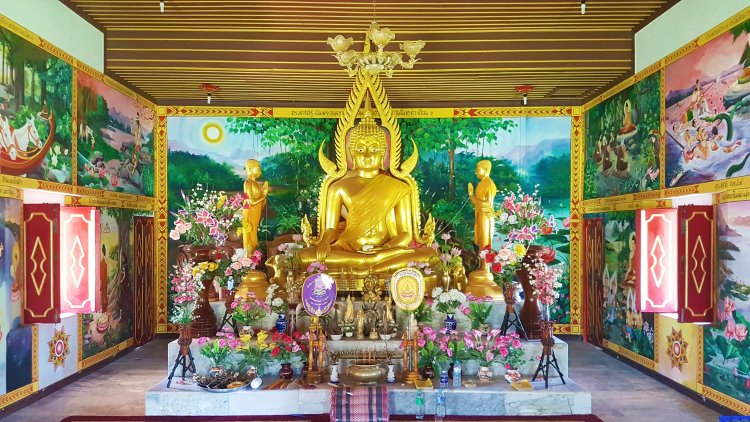Exploring India’s Most Revered Buddhist Tourist Destinations
India, the birthplace of Buddhism, is home to some of the world’s most revered Buddhist tourist destinations. From ancient monasteries nestled in the Himalayan foothills to sacred sites that attract pilgrims and travelers alike, the country offers a rich cultural and spiritual journey through its Buddhist heritage. Whether you're a devout follower of Buddhism or a curious traveler seeking a peaceful retreat, India’s Buddhist tourist destinations hold immense historical, spiritual, and architectural significance. In this article, we’ll explore some of the most significant Buddhist tourist destinations in India, offering a glimpse into the history and culture that shaped this ancient religion.

India, the birthplace of Buddhism, is home to some of the world’s most revered Buddhist tourist destinations. From ancient monasteries nestled in the Himalayan foothills to sacred sites that attract pilgrims and travelers alike, the country offers a rich cultural and spiritual journey through its Buddhist heritage. Whether you're a devout follower of Buddhism or a curious traveler seeking a peaceful retreat, India’s Buddhist tourist destinations hold immense historical, spiritual, and architectural significance.
In this article, we’ll explore some of the most significant Buddhist tourist destinations in India, offering a glimpse into the history and culture that shaped this ancient religion.
1. Bodh Gaya, Bihar
Arguably the most important Buddhist site in India, Bodh Gaya is where Lord Buddha attained enlightenment. Located in Bihar, this sacred site draws pilgrims from all corners of the world. The Mahabodhi Temple, a UNESCO World Heritage Site, stands as the centerpiece of Bodh Gaya. This ancient structure houses the Bodhi Tree, under which Buddha meditated and achieved enlightenment. Visitors can walk around the temple complex, meditate, and soak in the serene atmosphere.
The surrounding area is dotted with various monasteries built by different Buddhist countries, offering a unique blend of global Buddhist cultures. The nearby Bodhi Tree remains an emblem of peace, and the Animesh Lochana Chaitya is another important spot for meditation.
2. Sarnath, Uttar Pradesh
Sarnath, located near Varanasi in Uttar Pradesh, holds significant importance in the history of Buddhism. This was the site where Buddha delivered his first sermon after attaining enlightenment, known as the Dhammacakkappavattana Sutta or the Turning of the Wheel of Dharma. The Dhamekh Stupa, a massive structure, marks the spot where Buddha preached his first sermon. It’s a symbol of Buddhism's deep roots in India.
Other notable Buddhist landmarks in Sarnath include the Sarnath Archaeological Museum, housing numerous Buddhist sculptures and artifacts, and the Mulagandha Kuti Vihara, a modern temple adorned with beautiful murals and sculptures.
3. Lumbini, Nepal (Close to the Indian Border)
Though technically located in Nepal, Lumbini is closely linked with India as it is the birthplace of Siddhartha Gautama, who later became Buddha. Lumbini is an essential pilgrimage site for Buddhists worldwide. The Maya Devi Temple marks the spot where Queen Maya Devi gave birth to the Buddha, and the Sacred Garden surrounding the temple is where visitors can meditate and reflect on the profound significance of the location.
Though just across the border from India, Lumbini’s accessibility makes it an important destination for Indian Buddhist tourists seeking to explore the roots of their spiritual journey.
4. Rajgir, Bihar
Located in Bihar, Rajgir is another important Buddhist destination that features in many of Buddha’s teachings. The site is not only historically significant but also offers stunning views of the surrounding hills. Rajgir was once the capital of the Magadh kingdom, and it was here that Buddha spent several years meditating and delivering sermons.
The Vulture’s Peak (Gridhrakuta Hill) in Rajgir is a key Buddhist site where Buddha is believed to have delivered many of his teachings. Visitors can take a cable car ride to the top of the hill and enjoy panoramic views. The Bimbisar Jail, where King Bimbisar was imprisoned, and the Venuvana Vihara are also major attractions for those exploring Buddhist history.
5. Kushinagar, Uttar Pradesh
Kushinagar, in Uttar Pradesh, is another pivotal destination in Buddhist tourism, being the site where Buddha attained Parinirvana (final nirvana) after his death. The Mahaparinirvana Temple is a key pilgrimage site, where the statue of a reclining Buddha symbolizes the peaceful passing of the Buddha into nirvana. The site also contains several stupas and monasteries, adding to its spiritual and cultural significance.
For those interested in Buddhism's final chapter, Kushinagar provides a profound experience as pilgrims visit the temple to pay respects and reflect on the teachings of Buddha.
6. Dharamshala, Himachal Pradesh
Dharamshala, located in the scenic hills of Himachal Pradesh, is another famous Buddhist tourist destination in India. It is also the residence of the Dalai Lama, the spiritual leader of Tibetan Buddhism. The town offers a peaceful and serene environment, attracting travelers from around the world to experience Tibetan Buddhist culture.
The Tsuglagkhang Complex in Dharamshala is home to the Dalai Lama’s temple, where visitors can listen to teachings, attend meditation sessions, and learn more about Tibetan Buddhism. The nearby Namgyal Monastery offers deep insights into Tibetan Buddhist traditions, and the town itself is filled with monasteries and Tibetan-inspired architecture, making it a must-visit destination for those seeking spiritual solace.
7. Spiti Valley, Himachal Pradesh
For those seeking more remote and tranquil Buddhist destinations, Spiti Valley in Himachal Pradesh is a hidden gem. Often referred to as "Little Tibet," Spiti Valley is home to ancient monasteries, beautiful Buddhist art, and a deep spiritual heritage. Key Monastery, perched high on a hill, is one of the oldest and most revered Buddhist monasteries in the region, offering incredible views of the valley below.
Spiti Valley offers travelers the chance to explore Tibetan Buddhism in a more intimate and less commercialized setting, making it an ideal destination for spiritual seekers and adventure enthusiasts alike.
Conclusion
India’s Buddhist tourist destinations are not just about beautiful landscapes and historic sites; they are places of deep spiritual significance. Whether you're a pilgrim, a history enthusiast, or a traveler seeking peace, these Buddhist tourist destinations in India offer a unique blend of ancient traditions, sacred architecture, and timeless teachings. From the enlightenment of Buddha at Bodh Gaya to the teachings delivered at Sarnath, these destinations provide a glimpse into the profound impact Buddhism has had on India and the world.
Exploring these revered Buddhist sites offers a rare opportunity to connect with India's spiritual legacy, making it a must-visit for anyone interested in understanding the roots and evolution of Buddhism.

What's Your Reaction?
















.jpg)